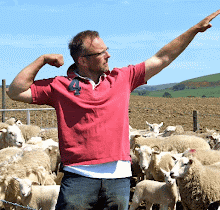The sheep industry in New Zealand has seen many changes. In 1980 there were 60 million ewes now there is only 23 million. Sheep in a lot of the South Island have made way for Dairy cows, Deer and even Vineyards. Yet despite all this they export the same tonnage of lamb. Lambing percentage has increased from 102% in 1980 to an average of 123%. Carcass weights have gone from 13kg to 17.6kg per animal.
In terms of breeds, the Romney still dominates at 40% of all ewes; thereafter there is the group known as “Other” at 29% (more of which to follow); the Coopworth (a stabilised Romney x Border Leicester) represents 12.2%; with the Perindale at 9.6%.
The “Other” category represents what are known as Composites and include Kelso, Rissington, Greline, Textra, Romdale and Coopdale ewes. I was forcibly told that what I, and everyone else it seems, called a Composite (cross bred sheep that has been stabilised by a number of back crosses) was nothing of the sort and in fact these should be termed Synthetics. Composites are really cross bred sheep that are constantly added to with new genetics (I scare myself with how interesting I can be).
The New Zealand “Composites” have probably peaked and are on the decline. Overly aggressive marketing and their failure to prove themselves under difficult conditions have checked their rise. The Finn and East Friesian breeds, which have a part to play in many of these sheep, add fertility but produce lambs which are incredibly hard to fatten. Processors hate them. Fertility may be there but some lack significantly in mothering ability. As the fashion was raging some suppliers made the mistake of supplying not the top rams, just all the rams and quality dropped. Quality will prevail and some Synthetics will be here to stay but the cynicism learnt from alot of broken promises will remain.
Sheep are just sheep and its perhaps overly optimistic to pretend otherwise.









No comments:
Post a Comment